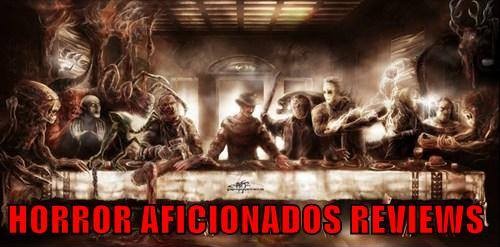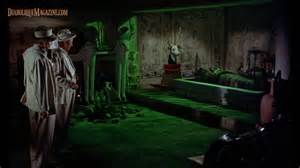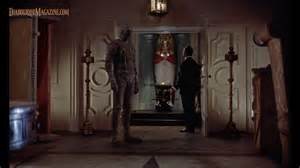

As I begin writing this, it’s Valentine’s day. Not only is this a day for love or consuming mass amounts of candy that will inevitably make you sick the next day, it also marks the 83rd anniversary of the release of Dracula, the immortal classic starring Bela Lugosi. This landmark film ushered in the Golden age of Horror films and is a cherished classic to this day; one that should be a quintessential part of every horror fan’s collection. Time may not have been as kind to Dracula as it has been to Frankenstein. It’s flawed, even for its time, but its an iconic film that contains some of horror cinemas greatest moments and sparked the career of the great Bela Lugosi.
Starting in 1921 with the Hungarian film, Dracula’s Death, the Bram Stoker novel had been adapted for the screen several times. The most famous being F.W Murnau’s Nosferatu in 1922. Most versions took extreme liberties with the source, with Murnau’s film surprisingly remaining the most loyal to it. However, all prints of these films were burned after Stoker’s widow sued for copyright infringement and only Nosferatu remains ( A tragedy and a true lesson on the importance of film preservation). After negotiations with Florence Stoker, Dracula was adapted as a play by Irish playwright and actor, Hamilton Deane. It was this version that would become the template for most of the Dracula adaptations to come. The play would eventually be moved to Broadway in 1927, where it received an over-hall, being re-casted and rewritten by John L. Balderston, who would go on to pen the 31′ film, along with many of Universal’s important monster movies of the 30’s. It was in this version of the play that the role of Dracula was given to the man who would become most associated with the character, Bela Lugosi.

Béla Ferenc Dezső Blaskó was born on October 20th, 1882 in Lugos, Hungary. He later changed his name to Lugosi in honor of his birthplace. The youngest of four children, Lugosi dropped out of school and began acting at the age of 12. He served as an infantryman, eventually rising to Captain in the Austro- Hungarian Army during World War I. He would obtain a Wound Medal after receiving an injury that would have serious repercussions later in his life, including a dependency on pain killers that would nearly destroy him. As part of the actor’s union during the Hungarian Revolution, Lugosi was forced to flee the country in 1919. He would continue acting in Berlin before eventually settling in the united states. Lugosi formed a stock company with fellow Hungarian actors and in 1922 would act in his first Broadway play, The Red Poppy. In 1927, he finally landed the role of Count Dracula in the revised version of Deane’s play and would portray the Count 261 times on the stage.

Universal founder, Carl Laemmle Sr. wasn’t fond of horror films and all of the ones produced during the silent era were very carefully chosen, always leaving out supernatural elements, instead settling on human monsters as the antagonists. Gothic horror and the supernatural were strictly a staple of European films. However, once Laemmle’s son began producing films at Universal, things began to change. Producer Carl Laemmle Jr. conceived of a Dracula adaptation as a big, lavish production in the vein of The Hunchback of Notre Dame, which would star Universal’s reigning horror star, Lon Chaney. Sadly, this was not to be, as Chaney passed away following a battle with throat cancer and the great depression caused studios to scale back considerably. Due to budget constants, the decision was made to base the film on the more limited Hamilton Deane play rather than slaving to the Stoker novel.

When Chaney was still attached to the film, the role of director was given to Tod Browning, who had previously collaborated with the man of a thousand faces on several Silent classics, including West of Zanzibar, The Unholy three, the unknown, and the lost vampire film, London after Midnight. Both Edward Van Sloan and eventually, Bela Lugosi were pulled in from the stage play to star as Van Helsing and the Count. Browning was reluctant to replace his friend, Chaney with Lugosi and spent much of the filming in a rather aloof state. While Dracula would have the distinction of being the first Horror film with sound, coming off of the silent era under the direction of a less involved director would make for a slightly troubled production and occasionally inept final product. German cinematographer, Karl Freund, frequent collaborator with famed director Fritz Lang on such films as Metropolis (1927) was rumored to have actually directed much of the film, with Browning being very low key on the set. The acting and stage direction owes more to the silent era and being based on the play, many of the special effects sequences are conveniently off camera. Dracula simply doesn’t fully take advantage of its cinematic possibilities.

Admittedly, there is a certain ineptness to Dracula, but while it’s flawed, there are some marvelous and spooky sequences as well.. Bela Lugosi brings so much to the role and perfectly captures the essence of the Count. Being from Hungary and not quite mastering the English language, Lugosi gives the character an authentic foreign and alien quality, making Dracula the strange outsider that he should be, while also giving him the charm and enigmatic quality that is most appropriate for the character. Another highlight is Dwight Frye as the lunatic Renfield, who steals every scene that he is in with his manic nature and unforgettable laugh. Rounding out the cast is Edward Van Sloan as Professor Abraham Van Helsing, who gives authority and grounding to the film’s supernatural qualities and creates a balance between the otherworldly Dracula and maniacal and tragic Renfield, and the more pedestrian characters like Harker, Seward, and Mina. The castle sets in the opening of the film are wonderfully constructed. With its dark shadows, long steps, cluttered spider webs, and state of disrepair, it’s the perfect gothic horror set. It’s an astonishingly gloomy film and while most of the London sets are somewhat pedestrian, there are also some very dreamlike forests, complete with a gorgeous layer of fog- an atmospheric and much cherished staple of black and white horror films. Odd choices like Armadillos and Opossums, who aren’t even native to Transylvania, instead of rats, end up being chilling and unsettling additions to the gothic castle. The first 20 minutes of Dracula are the most memorable and serve as some of the most atmospheric scenes, not only in Universal monster films, but in all of horror cinema. That’s not to discount the power of later scenes scattered throughout, such as the horror aboard the Vesta on its way to London during a storm, the woman in white, Dracula leading Mina through the forest, the climax of the film, or any scene featuring the crazed Renfield. Karl Freund’s lighting perfectly highlight’s both Lugosi’s and Frye’s Eyes, making them really stand out for dramatic effect. This lighting manages to make Dwight Frye look even more bug eyed and frightening than he would have been otherwise. The same can be said about Lugosi’s hypnotic stare, which is better achieved through this effect.

Unfortunately, like a stage production, some of acting is a bit stilted and there is virtually no camera movement, making much of the film rather static. Without the benefit of a musical score, much of the movie plods along at an uneven pace. In some scenes, it could have benefited from it, though I will admit that the quietness does add a level of creepiness in some of the more pivotal scenes. However, other films of the period work just fine without music so it’s more of a problem with the static camera, staging, and editing than it is with the long bits without sound. David Manners and Helen Chandler are a bit dull as the leads, Jonathan Harker and Mina Seward. While Chandler at least has the excuse of being under Dracula’s spell for much of the second half, Manners is just completely over the top and annoyingly wooden. There is a certain amount of sleepiness that comes along with both of their performances that keeps their characters from ever being completely compelling or altogether likable. Compare them to characters in one of James Whale’s horror films or even one of Browning’s more hands on productions and you’ll find a very glaring difference. Many of the London sets are also a bit bland, especially in comparison to the horrific gothic castle from the opening. The biggest problem with Dracula’s pacing is that it reaches its most visually interesting scenes in the very beginning and only occasionally captures that level of atmosphere again. Dracula is still a very bizarre and unconventional horror film, but I feel that some of it really could have been pushed a tad bit further. Under the helm of an enthusiastic James Whale, Universal’s next horror film, Frankenstein would completely steer away from Dracula’s mistakes and is much more even. At the end of the day though, Dracula is still a wonderful, classic film. It has its flaws, but both Lugosi and Dwight Frye are completely captivating. There are shades of brilliance that still manage to come through in this troubled production. More than just paving the way for the coming Universal classic monster films, John L Balderston would use it as a virtual stepping stone when writing The Mummy (1932), which really plays as a more refined and perfected version of Dracula in a lot of ways. All the more funny that that film was also the directorial debut of Dracula’s cinematographer, Karl Freund.

Dracula was a massive success for Universal and would become the first in a wave of films that turned them into the reigning house of horrors through the 1930’s, which consisted of such classics as Frankenstein, The Old Dark house, The mummy, The Invisible man, The black cat, The Raven, Werewolf of London, The Bride of Frankenstein, and Dracula’s daughter, before the genre went on a virtual hiatus in 1936 (coming back in 1939 with Son of Frankenstein, starting the second wave of Universal horror). Tod Browning would go to MGM, where he would direct his masterpiece, Freaks in 1932, along with Lugosi in another Dracula type role in Mark of the Vampire (1935), and the underrated The Devil Doll (1936), before fading into obscurity. It made a star out of Bela Lugosi, who would tragically face many downs for the remainder of his career with an addiction to Demerol and Methadone and a dive into Poverty Row trash films after his relationship with Universal Studios, MGM, and Columbia waned. Ironically, Lugosi’s last starring role for a major studio would be a return to the role of Dracula for the second time on film in Abbott and Costello meet Frankenstein (1948). After that, he would eventually plunge into exploitation films with Edward D Wood Jr before his death on August 16th, 1956. He was buried in his Dracula cape, going to the grave as the immortal character that the public most remembered him for. Along with his portrayal of the count, he lives on in the hearts of horror fans everywhere and his popularity and recognition today far eclipses even his A- list contemporaries.

In closing, while Dracula isn’t a perfect film, it’s still a great example of classic horror cinema. It’s an important piece of work that I highly recommend to anyone who considers themselves a true horror fan. While I don’t think it’s the cinematic achievement that Frankenstein or its sequel, The Bride of Frankenstein are, it’s still one that I cherish very much. Dracula and especially the actor, Bela Lugosi are very dear to me. In fact, while I type this, the theatrically poster hangs above me on the wall, with Lugosi’s commanding presence looming over me. Some of my earliest childhood memories are of those creepy moments in his films, where I would huddle by the television in the dark, transfixed by the glowing, otherworldly black and white images that reflected upon my seven year old face. Watching these old films is like peering into a window to the past, seeing a dream or fantasy filtered through the celluloid of a bygone age. There are few cold, foggy nights where I don’t look up at the night sky and find myself reminded of Lugosi’s charm or hear a noise coming from the dark without recalling Edward Van Sloan’s words from Dracula’s original ending – ““When you go home tonight, and the lights have been turned out, and you are afraid to look behind the curtains, and you dread to see a face appear at the window. why, just pull yourself together and remember that, after all. there are such things..!”
Goodnight.

-Lawrence S. Talbot
















































